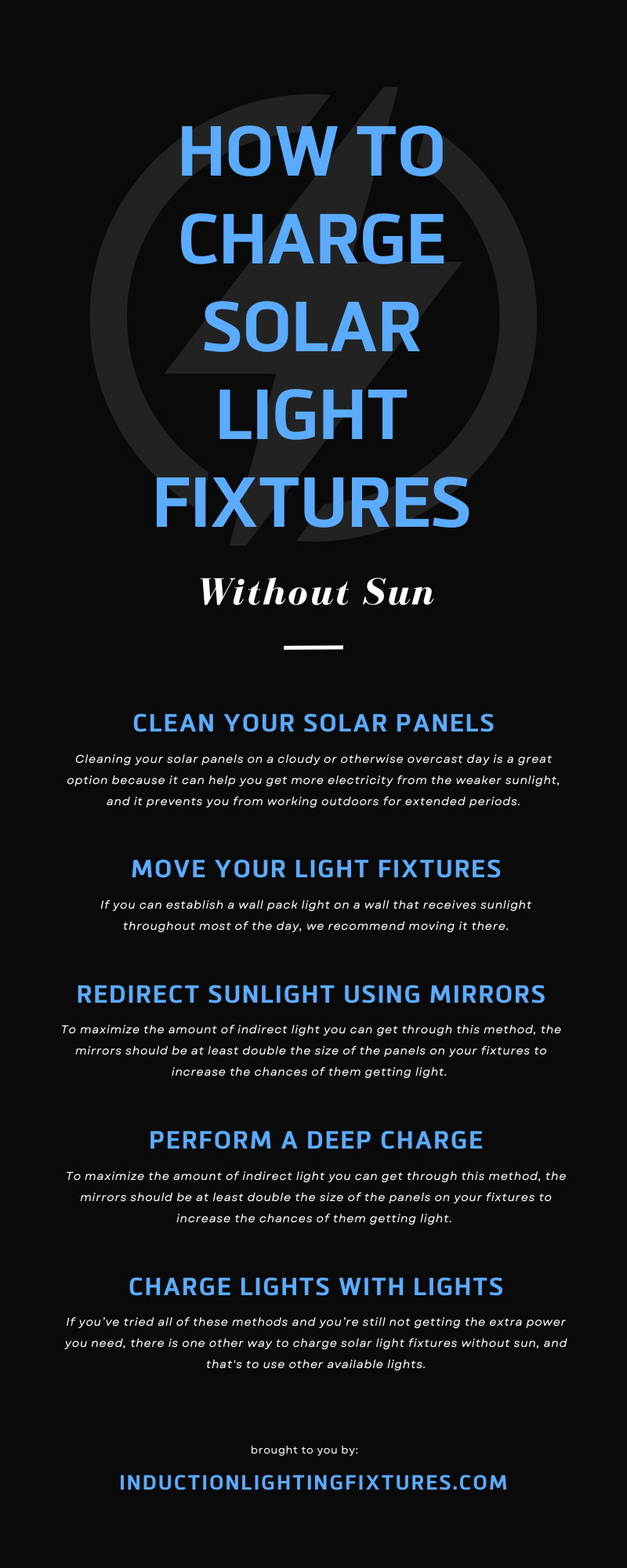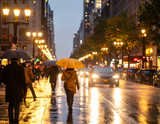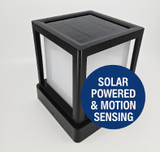How To Charge Solar Light Fixtures Without Sun
Many people have preconceived notions about how solar light fixtures work. They get it in their heads that these lights require constant exposure to direct sunlight in order to get any power. While there is some truth behind the belief that direct sunlight is the best way to get power to these fixtures and direct electricity to the battery, it’s not the only option.
There are many ways to charge solar light fixtures without sun, or at least without sunlight providing unmediated power. If you have solar light fixtures around your property, whether wall pack or post top, you may want to consider some of these tips to ensure you can get the most power out of them when you cannot rely on the aid of sunlight.
Clean Your Solar Panels
If you’re trying to get solar energy without sunlight, you want to eliminate as many other potential obstructions as possible. Cleaning your solar panels on a cloudy or otherwise overcast day is a great option because it can help you get more electricity from the weaker sunlight, and it prevents you from working outdoors for extended periods.
You want to be as gentle as possible when cleaning your solar panels because smudges, scratches, and other common side effects of cleaning may actually reduce their overall effectiveness. We suggest using clean, warm, soapy water and a microfiber cloth. You should avoid using detergents or ammonia-based cleaners because they may cloud up and obstruct your panels, making it more challenging for them to charge.
Depending on the physical location of your panels or the time of year, you may need to clean them more frequently. Pollen, sandstorms, snow, and rain droplets can build up on top of your panels and make them less effective, especially when attempting to gather power with reduced sunlight.
Move Your Light Fixtures
Unfortunately, you can't always control how the movement of the sun lines up with where your light fixtures need to go. Ideally, you want to have your fixtures receive as much direct sunlight as possible throughout the day. Ensuring unobstructed sunlight is easy for post-top lights that illuminate a parking lot, but for wall pack lights on sides of a building that don't get as much sunlight, direct sunlight is not always an option. Wall pack lights typically help guide people to entrances of the building and illuminate walls to alleviate safety concerns. If you can establish a wall pack light on a wall that receives sunlight throughout most of the day, we recommend moving it there. However, even lights that don't get as much sun throughout the day can still receive power through more indirect methods.
Redirect Sunlight Using Mirrors
In dire situations where you have light fixtures that don’t get direct sunlight and don’t enough power to get through the nighttime hours, you can use mirrors to try and angle the sunlight directly onto the panels. For several reasons, this is a mostly ineffective method that works best as a last resort, but it may help you get some extra sunlight.
To maximize the amount of indirect light you can get through this method, the mirrors should be at least double the size of the panels on your fixtures to increase the chances of them getting light. An unfortunate side-effect of this method that contributes to its inefficiency is that you typically need to move the mirrors throughout the day, or else the sunlight will quickly start to angle away from the panels. Mirrors aren't the best solution, but they can get you some extra power in a cost-effective way. The ease of this process may vary depending on how much extra sunlight your lights require and the number of fixtures you need to charge.
Perform a Deep Charge
Typically, solar light fixtures absorb sunlight during the day, transfer power to the battery, and utilize that power throughout the night. However, your fixtures may benefit from a process known as a deep charge. Deep charges involve turning your light fixtures off for 48 to 72 hours. This period of disuse gives them time to gather sunlight and store it in the battery without using it right away, essentially giving you a more charged battery than you’d have at the end of a single day.
Performing a deep charge once a month on any solar lighting is recommended, as the process can help extend the overall lifespan of your fixtures. If your business or property is closed on weekends, it may be beneficial to turn the fixtures off at the end of Friday’s workday. If your property always requires lighting, it may be worthwhile to install additional fixtures and alternate which lights receive the extra time off to charge.
Charge Lights With Lights
If you’ve tried all of these methods and you’re still not getting the extra power you need, there is one other way to charge solar light fixtures without sun, and that's to use other available lights. Strong incandescent or LED lightbulbs can effectively charge solar panels and give the batteries some much-needed power. Typically, you want the lightbulb to be positioned directly above the panel so that your solar light fixtures can absorb as much light as possible. The only problem with this method is that it can be counter-intuitive if the light that's charging the panel isn't serving some other purpose.
A common mistake that many people make is believing that they can use a non-solar-powered light to charge the solar panels while they're running. Attempting to give more solar energy to a battery while it's lit is one of the quickest ways to damage them and lead to a loss in sensitivity, making them less effective during daylight hours. If you plan to use lightbulbs to charge your solar fixtures, you should always do it throughout the day and not while they’re running at night.
To learn more about how solar-powered wall pack lights work and how they can benefit your business or other property, Induction Lighting Fixtures is here to help you. We have a wide range of helpful guides on proper sustainable lighting options and many top-quality products available on our website. If you have any additional questions, you can chat with a member of our team on our website or contact us anytime for more details.

Recent Posts
-
How Long Will Solar Powered Lighting Operate in the Rain?
How Solar Light Fixtures Can Run for 10 Rainy Days If you’ve ever wondered how a Commercial solar li …Jul 30th 2025 -
Spotlight - The IL-SPG54 Smart Solar Walkway Light: Where Performance Meets Simplicity
Introducing the IL-SPG54 Smart Solar Walkway Light: Where Performance Meets Simplicity When it comes …Jun 16th 2025 -
Corn Bulb Sale - While supplies last!
⚡ Limited Time Sale – BLE Series Corn Lamps Starting at $24.99! Stock up now while supplies last – p …Jun 11th 2025






